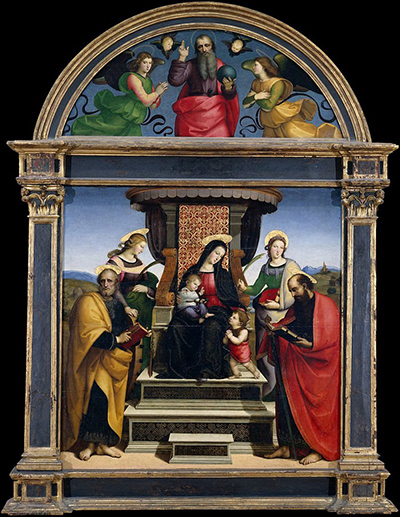 Buy Art Prints Now
Buy Art Prints Nowfrom Amazon
* As an Amazon Associate, and partner with Google Adsense and Ezoic, I earn from qualifying purchases.
Madonna and Child Enthroned with Saints by Raphael is a painting completed in 1504-5 by an Italian painter named Raffaello Sanzio da Urbino (Raphael)
Also known as the Colonna Altarpiece (thanks to its home for over a Century years), the painting was done during the Renaissance period and was heavily influenced by the Catholic Church and the Umbrian designs associated with Perugino, his master and teacher.
The painting was drawn on wood using oil and gold on a 172.4 cm by 172.4 cm frame. The complete Altarpiece had three Predellas; The Passion of Christ – The Agony in the Garden (Morgan Library, New York), The Procession to Calvary (National Gallery, London) and the Pietá (Isabella Stewart Gardner Museum, London).
Being an architect, Raphael used geometry in this painting, despite the free-flowing paintings during his time. This is evident in the painting of the throne steps, the space between the Saint Peter, Saint Paul and the background, and the throne design.
The painting is a representation of Saint Peter, Catherine, Lucy, Saint Paul, Young John the Baptist and Young Jesus at the throne. Jesus is the one sitting on Mary’s laps and is seen blessing John the Baptist, who is at Mary’s feet. The other four saints are gathered around the throne, probably reading the benediction.
Mary sitting on the throne is a symbolic gesture among Catholic Church believers because she is considered the saviour of the world. The square part of the painting where the benediction is happening represents the world, evident in the background with hills, a tower and general vegetation, while the semi-circle canopy shows the Godly world, complete with God and two angels.
Madonna was prominent within art from the Renaissance ever onwards, with other significant contributions including Madonna della Vallicella, The Madonna of the Lilies, Coronation of the Virgin, Madonna of the Yarnwinder and Dreyfus Madonna.
The painting was commissioned for nuns at Franciscan Convent of Sant’ Antonio in Perugia until 1661 when it was sold to the Queen of Sweden and later found its way to the Colonna family by 1689. It was bought by J. Pierpont Morgan in the early twentieth century before finding its current home.
In between the 15th and 16th Century, the painting was showcased in art exhibitions in Italy, Spain, France, United Kingdom and the United States of America. Although replicas of the painting are found all around the world, the Masterpiece is held by the Metropolitan Museum of Art in New York.




